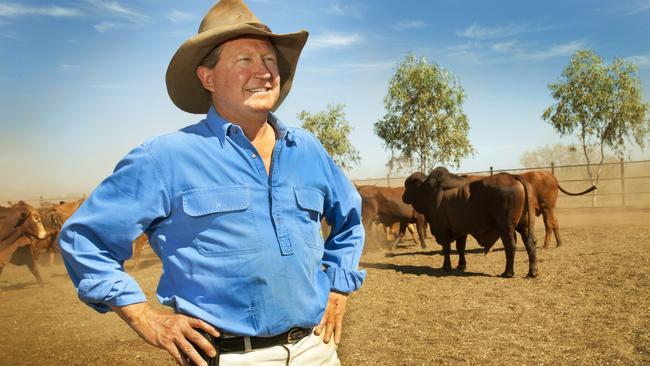Doubts over Fortescue green plans bring out Andrew Forrest to pitch the dream to investors


Forrest surprised the market last year when he used Fortescue’s annual shareholder meeting to announce plans for Fortescue to eventually produce 235 gigawatts of renewable energy a year, or five times the current capacity of Australia’s National Energy Market.
Those plans were obviously in train well before the announcement – Forrest, and a Fortescue team that included some of its best operators, had been traipsing the globe for months to stitch up early stage deals to win a seat at the table on major renewable energy projects.
Since that formal announcement Fortescue Future Industries (FFI), as it is now known, has been reliving the company’s happy past as an upstart player in an industry dominated by an established energy oligopoly, releasing a slew of its own press releases to spruik the dream of early stage opportunities to investors.
But the potential cost of those developments is eye watering.
The cost of developing Fortescue’s first iron ore project in the Pilbara, at the Chichester hub, was put at $2bn in its early days – a figure seen as impossible for a new producer up against Rio Tinto and BHP.
Only a few weeks ago the potential investment in only one of the Fortescue Future Industries projects, an industrial estate in Indonesia, was tipped at $US12bn by Indonesian authorities.
There is, to be fair, a vast gulf between the Fortescue of 2005 and the $60bn cash machine that exists today. But the total costs of the projects FFI is involved in still dwarf its market capitalisation.
Which is, presumably, why Forrest has hit the trail to do what he does best – convince the sceptical that he can deliver the blue sky.
On Monday Forrest sat in on media and analyst briefings on the company’s annual results, to the surprise of most of the participants.
While the Fortescue founder led a round of analyst and investor briefings earlier this year in the wake of the announcement of its plans to get involved in the green energy business, Forrest hasn’t sat in
on a routine earnings call for years.
The fact he did so on Monday – and not to bask in the glory of record profits and a massive return to shareholders, but to sell the next phase of the Fortescue evolution – suggests the company is aware that it needs to bring out the big guns to sell the dream.
Forrest’s presence on Fortescue’s full year earnings calls on Monday – both the media and analyst calls – is surely a recognition of the growing concerns among analysts and investors about Fortescue’s spending on his ambitious plan to reinvent the company as a global green energy giant.
Forget the political partisans and the “go woke, go broke” brigade, last seen making hay out of the decision by Australia’s other great export commodity over the last decade, the Wiggles, to try to look beyond an all-white and middle class audience by adding new members.
The doubts in the market came to a head when Fortescue put a number to its plans for its green ambitions – 10 per cent of net profits going forward, and $US400m-$US600m ($550m-$820m) in the current year.
After Fortescue’s full-year production results in July, Fortescue chief executive Elizabeth Gaines was repeatedly challenged by analysts and investors to provide more detail on how the company’s spending on FFI was adding value for shareholders.
Pendal Group fund manager Brenton Saunders put it bluntly, telling the Fortescue boss the mining giant “owed it to shareholders” to outline the business case for its spending.
“I think decarbonisation is a process, not an investment case or a business case. And I honestly think you owe it to shareholders to properly articulate what those projects are and what the business case is around them,” he said.
In response, Forrest’s sales pitch to analysts on Monday was purely commercial.
The Fortescue founder is not the Red Ink Wiggle, and saving the planet from global warming can offer great returns to shareholders.
The inputs – sun, wind and water – are free, and only access, technology and capital costs stand between Fortescue and massive returns.
“The commodity itself is free. It’s the most ridiculous copper, gold, iron ore deposit I’ve ever seen. It has no overburden, therefore no strip ratios. It comes in at the grade you want, and it goes on forever. Oh and it costs nothing,” Forrest told analysts.
“While we have to get through a capital cost and an electronic and chemical operating cost – which is a fraction of anything I’ve ever seen in the mining industry – once we’re going, our own operating costs become extremely competitive against any sector. And that is of course a major driver for the future profitability for Fortescue.”
On the one hand, looking at Fortescue’s results this year, you’d be a fool to bet against Forrest. Anyone who doubts his ability to spot an emerging market should go and have a look at the 2003 presentations when Forrest listed his Pilbara iron ore play into the shell of little-known hopeful Allied Mining and Processing.
At the time iron ore was worth about $US30 a tonne, and the idea of challenging Rio Tinto and BHP’s dominance of the trade was outrageous.
On the other hand Forrest’s pitch to analysts on Monday – that Fortescue is the best returning stock of its generation, and he can do it again – skates over the company’s near death experience in 2012, when the iron ore price plunged amid a new surge in supply.
Only time will tell which version will play out this time.





Andrew Forrest has made his fortune by thinking big and delivering on blue sky promises. As Fortescue looks beyond its iron ore business and plots a path to becoming the “new force” in green energy, Forrest is back hustling the market to sell the blue sky.